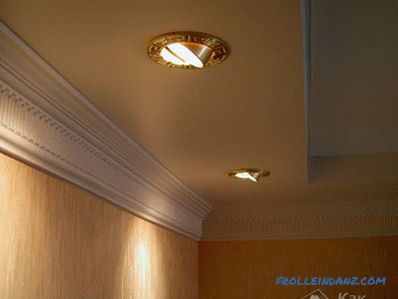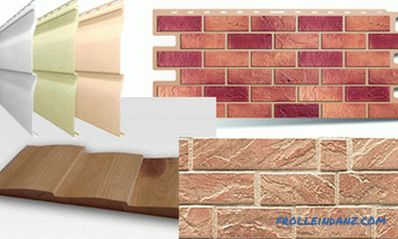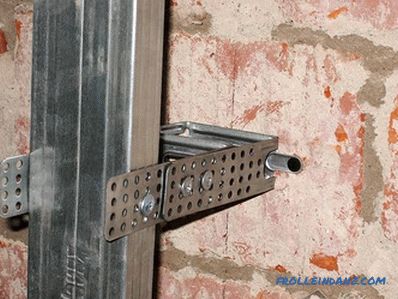Regardless of where your cottage is located or a private house, you need to carefully prepare the territory. This issue is particularly relevant in hilly terrain. In this case, special fortifications are used. Thanks to the retaining walls, you can protect yourself from creeping and collapsing soil in the garden and in the yard. In this article, you will learn how to do the retaining wall with your own hands. Also, you will learn about what materials and methods for the construction should be used will be discussed in this article.
Retaining walls in modern landscape design
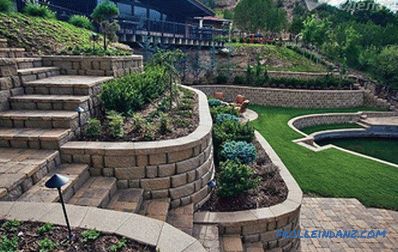
At the very beginning it is worth noting that any piece of land has its own individual shapes, relief and size, which should be considered . In addition, it is necessary to take into account personal preferences, style of the house and other buildings. Even types of garden paths can affect the choice of material and the shape of the retaining wall. If the garden area is small, the maximum height of the retaining wall should not exceed 60 cm.
Large walls will create a feeling of heaviness when inspecting the entire area. Experts recommend adding to these various architectural elements:
- niches;
- steps;
- benches;
- tables.
In addition, the selected material will also affect the overall appearance of the landscape design. Considering the options you need to take into account all the design ideas that will be implemented in the territory. So, for the monumental supports apply textured and embossed materials, dimensional stones of different shapes or powerful logs. To create a sophisticated landscape design fit plaster, small stones (gravel or crushed stones).
A properly constructed retaining wall will simultaneously perform several functions:
- zoning of the site;
- landscape design transformation;
- strengthening;
- protection;
- solving the problem of uneven terrain.
If your site is too pronounced, then you should consider options with a vertical layout. It lies in the fact that the entire area is divided into several sections, each of which has its own horizontal level and is fixed with a support.
Components of the retaining wall
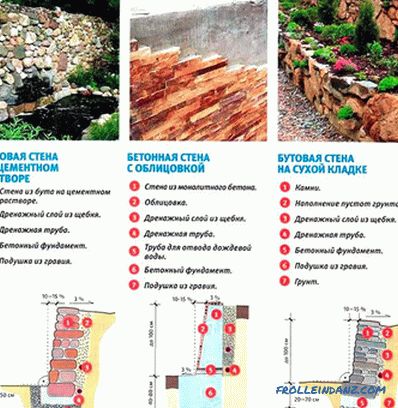
Each retaining wall to be built in landscape design should consist of four main parts:
- The foundation is underground, which allows you to take on all the pressure from the soil pressure.
- The body is the vertical part of the structure above ground (the main part).
- Drainage is necessary for the removal of water, since the excess moisture will destroy the backwater.
- Drainage - the remaining water will be absorbed into the layer and, when dry, will release moisture to nourish the plants.
The wall can be made of virtually any material that is suitable for the local climate and the amount of precipitation. You can install it almost anywhere, but regardless of the planned height, it should consist of all 4 components.
By carefully considering each step, you can end up with a durable retaining wall. To work enough to use their strength and low-cost materials.
Parameters affecting the strength and stability of the structure
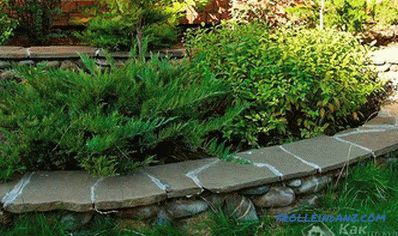
With proper planning, the wall will be as stable as possible. She will be able to withstand any stress and pressure. If this is not foreseen, the soil will slide back, and the decorative wall is destroyed. To avoid this, it is necessary to take into account many factors that directly affect the strength of the whole structure. Primarily physical forces will act on the retaining wall:
- the weight of the structure;
- soil pressure;
- friction force;
- soil adhesion ;
- the weight of the decorative elements.
Other phenomena will also affect the retaining wall:
- soil swelling in winter;
- strong wind (for walls more than 2 m high);
- vibration (in cases where the railway tracks pass nearby),
- seismic events (regional features are taken into account);
- groundwater;
- rainwater washout.
There are other recommendations that should be considered before planning and calculating future retaining walls:
- To ensure maximum adhesion to the ground, the back wall should be rough.
- Also, the rear end should be carried out on an incline to the soil being held.
- To reduce the pressure on the wall in the ground it is necessary to lay hollow elements with low weight.
- To reduce the likelihood of tipping from the front side, it is necessary to indent the console.
In addition to the above factors, there is another one - the thickness of the retaining wall. To calculate it, you must consider the type of soil and the height of the structure. For soft soil and high walls choose wide protective shields.
Basic materials
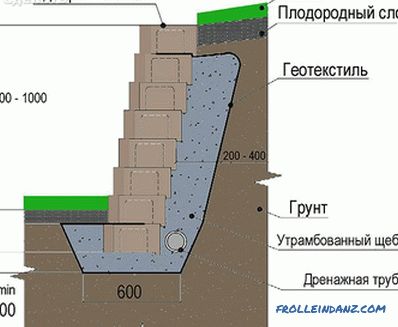
Before you make a wall, you need to select a material. Among the most common are:
- brick;
- wood;
- stone;
- concrete;
- gabion.
Wood
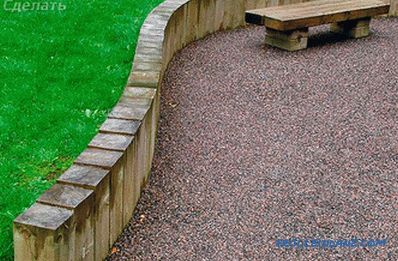
It is believed that the simplest and easiest material is wood. It will be much easier to build a wall from it than from a stone or gabion. To create a wall, select logs with a height of 1 to 1.5 m. At the same time, 50 cm must be in the ground, and 1 m will serve as a protective support.
The part of the logs that will be immersed in the ground requires special treatment in order to last longer. For this purpose, special modern tools or hot bitumen are used.
Trench dimensions should be 10-15 cm larger than logs. The bottom is covered with a cushion of gravel and compacted. When installing lumber, you can use wire to increase the density of the wall. You can also use nails as fasteners. After installation, the trench is poured with concrete.
Concrete
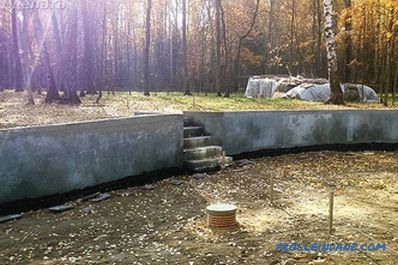
This material is the most durable and practical. Such walls can withstand even a lot of ground pressure. If you attach a little imagination, then this design can be very presentable. Also in the case of concrete, decorative materials can be used for decoration:
- stone;
- tile;
- brick.
It is necessary to begin construction from the foundation, namely from the trench. The maximum depth is 50 cm. All technology is identical, as is the case with any building or fence. The formwork and cushion and waterproofing layer are arranged. Structural strength is ensured by reinforcing mesh.
Stone
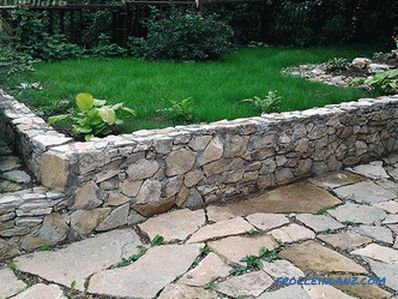
For the construction of retaining walls of stone can be used dry masonry or cement mortar. A huge range of natural and artificial stone allows you to choose the right option for landscaping on the garden plot, made in any style. The most commonly used:
- granite;
- basalt;
- quartzite;
- diabase;
- shell rock.
The foundation for the stone retaining wall is made of concrete. The width should be 2 times the wall itself. If the clutch will form voids, then they are overwritten with a special mixture. When dry laying stones in the seams use garden soil, in which plants are then planted.
Brick
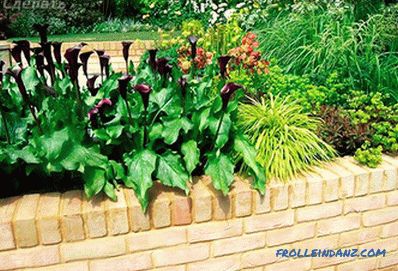
Quite often, after repair and construction work, there remains a brick, both solid and chipped. You should not throw it out or sell it, because from it you can build a beautiful, but rather strong retaining wall. Masonry differs little from the technology of building a house. The only difference is thickness. For a wall with a height of 60 cm, it is possible to carry out laying in half-brick, the width of one brick should be intended for a support of 1 m or more.
Gabions
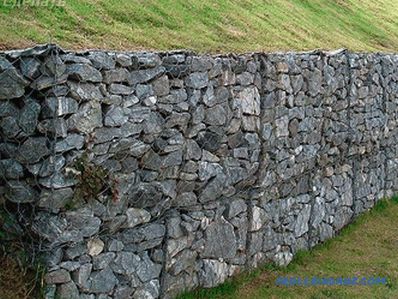
Recently, constructions from gabions are often used to enclose a private territory or when creating architectural and decorative elements. The basis of the design includes blocks of wire filled with stones. It is worth noting that in this case there is no need to equip the foundation, but for large structures additional fastening is necessary. All blocks are fastened together with galvanized wire. When laying the stones, decorative and beautiful elements are laid on the front side. The remaining volume can be filled with more simple stones:
- rubble;
- cobblestone;
- pebble.
The construction technology of a retaining wall on a relief section will directly depend on the material from which it will be made. When forming a retaining wall, it is not necessary to apply a flat, horizontal line. This can be a wave or arbitrary patterns.
Drainage for a retaining wall
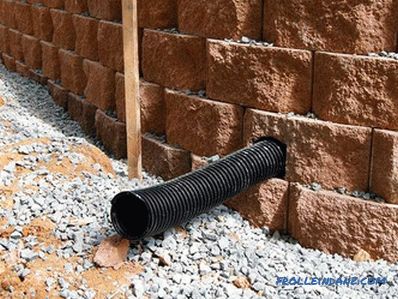
When erecting a retaining wall, you must take care not only of strength and high quality, but also of the organization of the drainage system. It is necessary to protect the back side of the wall from excessive moisture. For the organization of such protection will require high-quality drainage - drainage system. Today, professional landscape designers offer 3 options for organizing water diversion:
- Underground drainage. The system is presented in the form of a special perforated drainage pipe, which is installed in the base of the wall. For reliability and protection, the pipe is wrapped in geotextiles. With its help, the water will not accumulate, and go along the laid route to the drain.
- Ground drainage. During the construction of the wall from the back side lay a layer of loose material (gravel or brick). It will not allow excess moisture to destroy the structure of the base of the retaining wall. Water will naturally go far into the ground.
- Filter.Drainage can be equipped with special filtration holes. They are made in the wall of stone or concrete. For this, when laying through a row, it is necessary to leave one vertical seam without a solution. Excess moisture will go through these seams.
Each territory needs a good drainage system, but special attention should be paid to regions with constant precipitation. A large amount of groundwater can adversely affect the structure.
Decorative finishing and decoration
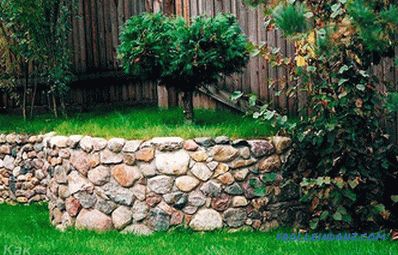
In order for the retaining wall not only to perform protective functions, but also decorative it is necessary to think about finishing. It is better to plan everything in advance and design it. The wall should harmoniously fit into the landscape design on the site. The most common method of decorative decoration today is planting. The best option would be to choose among ground cover species that successfully underline any element of the landscape plot.
Among the common options is to highlight several design options. One of these is an artificial pond or fountain. The alpine slide will look no less attractive. Climbing plants will stumble across the entire retaining wall. Moss will also be an interesting option. For this, the wall can be poured with kefir - this will speed up the growth of plants, as well as make the structure old.
A competent combination of colors and materials used will help to prevent possible mistakes. For example, if the buildings in the territory are made of wood, then the wall must also be made of lumber.
The retaining wall can be an excellent addition to a planned landscape project, as well as perform protective functions. Since it is under the open sky, it is constantly exposed to atmospheric influences. In order to protect the interior of the structure, it is necessary to carefully treat the seams of the brickwork Use special sealants, they allow you to protect the support from damage or deformation. Various experiments with decoration will allow you to get original and unusual results.
Video
This video gives practical recommendations on how to make a durable retaining wall:
Photos
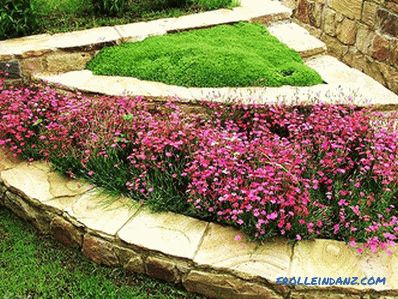 Retaining wall in the garden
Retaining wall in the garden
 Wall decor
Wall decor
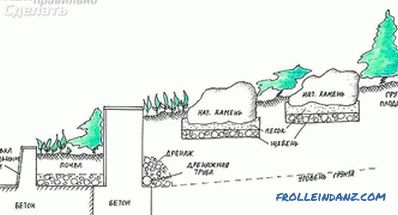 Device layout
Device layout
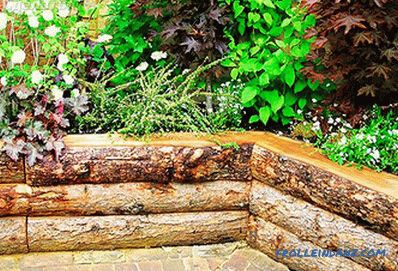 Wood retaining wall
Wood retaining wall
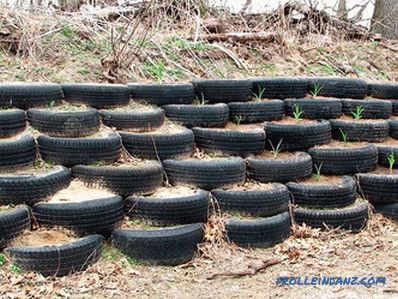 Of the tires
Of the tires
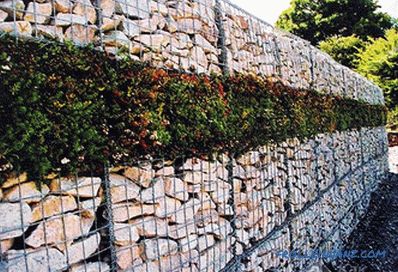 Wall from gabions
Wall from gabions
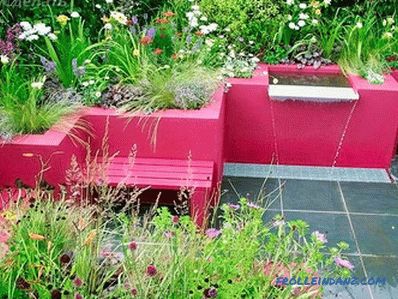 Brick construction
Brick construction
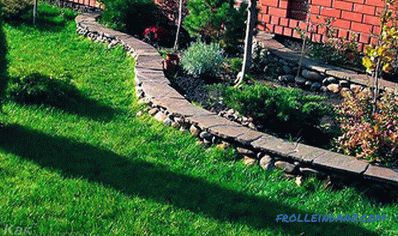 Stone
Stone
 Dressing
Dressing
